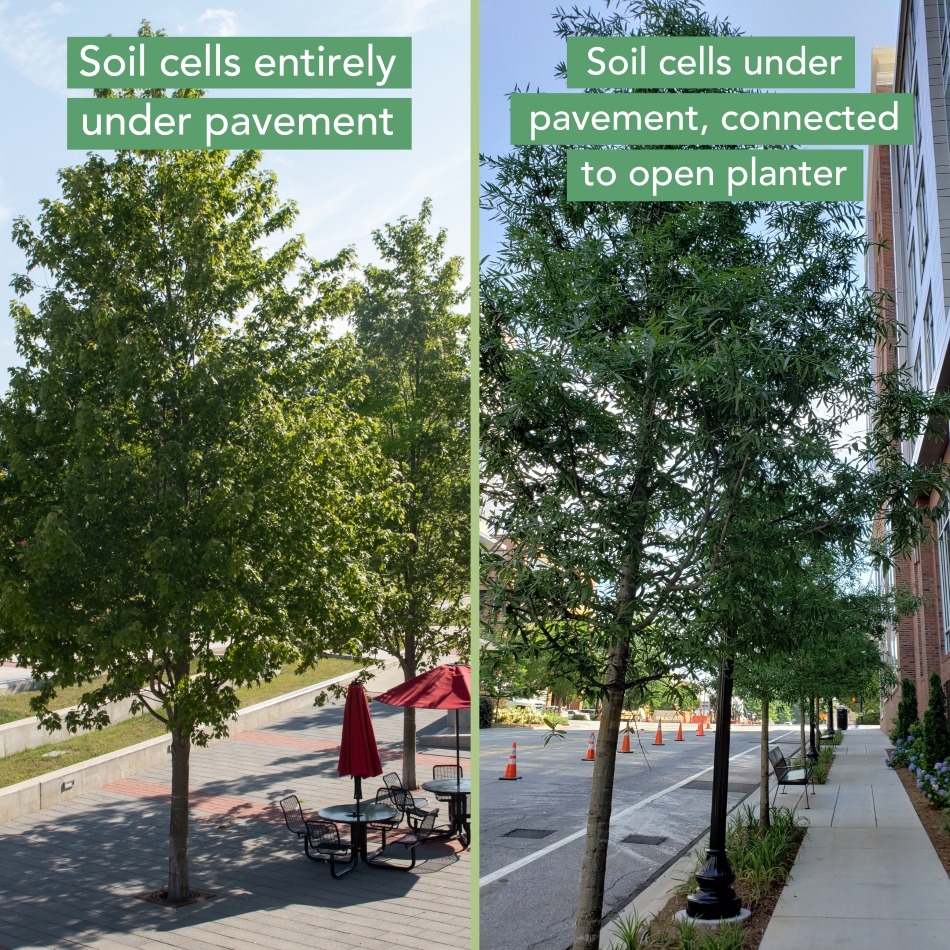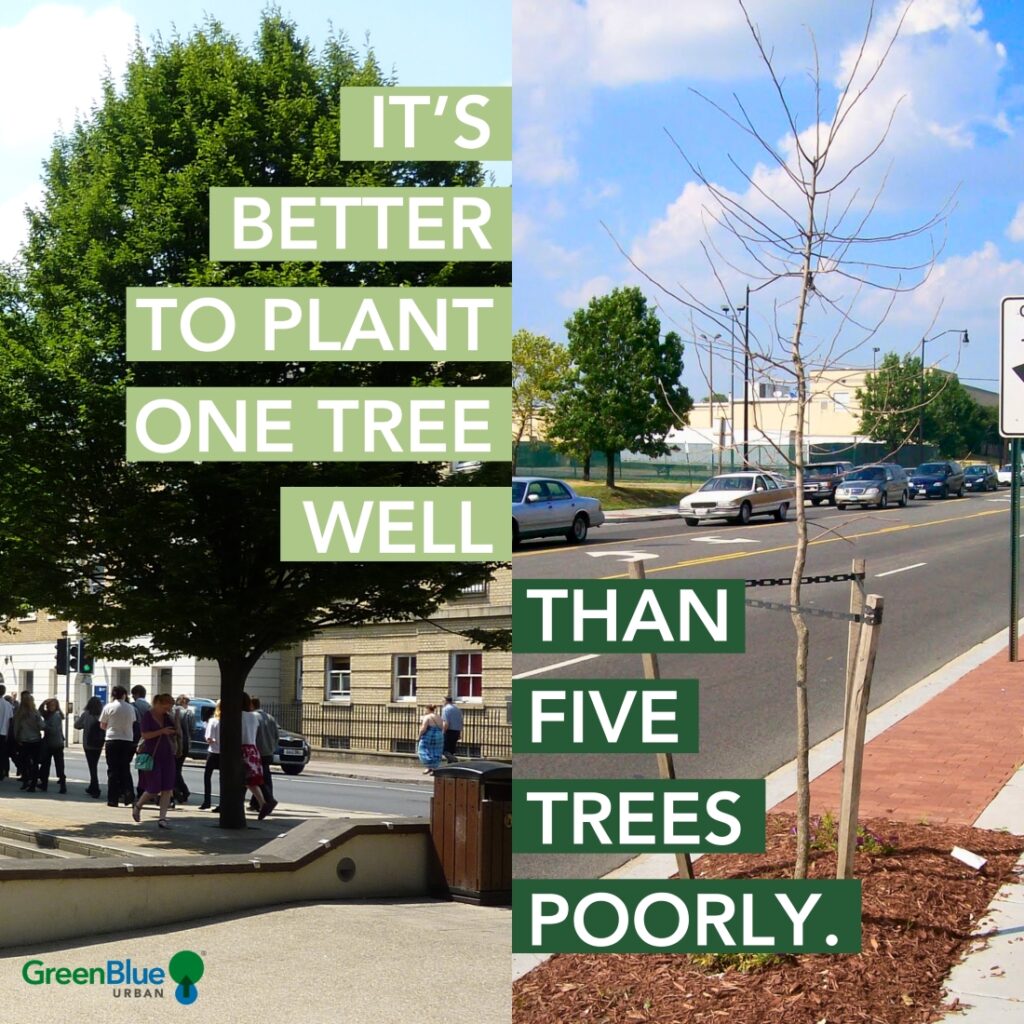It can be frustrating for landscape architects and designers not knowing the approximate cost of soil cells before specifying the system. This can lead to designs exceeding budget constraints, potentially resulting in value engineering later in the project. While the importance of proper tree planting techniques is widely recognized, balancing this with client budgets remains key.
And while there are many factors that can influence the cost of soil cells (which we’ve detailed in depth below), we want you to be prepared and informed for your client. With this in mind, here are our current average prices per square meter for our 3 most common soil profiles.
400 mm soil profile (RootSpace Airform 400) – $215-245 (CAD) per m2
600 mm soil profile (RootSpace Airform 600) – $230-260 (CAD) per m2
1000 mm soil profile (RootSpace Airform 1000) – $335-380 (CAD) per m2
Pricing is based on a tree pit with a 1m x 1m tree pit opening. All values are in Canadian dollars.
 What is included in the price of a soil cell system?
What is included in the price of a soil cell system?
RootSpace Airform Soil Cell Modules
ReRoot Barrier – to manage roots downward
RootStop Barrier – to keep roots within the system
RootRain Rootball Aeration/Irrigation
What is not included in the price of a soil cell system:
Aggregate
Planting Soil & Trees
Installation Labor
Underdrain and irrigation system (if specified)
Factors that influence these prices:
Sometimes we hear comments like, “While I would love for the trees to survive and thrive, I have a lot of competing priorities on this project, and with landscape often being the last to go in, I don’t have unlimited budget to throw at it. What economical options are available?”
Urban tree planting is typically a case where “you get out what you put in.” We advocate for a long-term, ROI-focused approach. However, certain design adjustments can maximize the value of your soil cell system without compromising tree health.
Here are some of our expert insights:
- The depth of the system:
- We like to say, deeper is cheaper – Using a deeper soil profile maximizes the cost of the soil cell components, and provides more soil volume per square meter.

Using a deeper profile by double-stacking the system (as shown in the cells at the back) is more cost-effective than using a single-layer system (shown in the front).
- We like to say, deeper is cheaper – Using a deeper soil profile maximizes the cost of the soil cell components, and provides more soil volume per square meter.
- The size of the tree pit opening:
- If space allows, create a larger opening for the tree. This can reduce the number of soil cells needed. A tree entirely under pavement with a grate, for example, will require more soil cells than a tree in a 1m x 2m open planter, therefore increasing cost.

Connecting a soil cell system to open planting areas can reduce the number of soil cells needed
- If space allows, create a larger opening for the tree. This can reduce the number of soil cells needed. A tree entirely under pavement with a grate, for example, will require more soil cells than a tree in a 1m x 2m open planter, therefore increasing cost.
- The layout of the system:
- Sharing soil between trees can reduce the soil volume required, as roots can share up to 20% of the soil between them. Connecting the cells to an open planting area can reduce the number of soil cells needed as well.
- The size of the system:
- Typically, a larger system will be more expensive. However, it will provide more soil volume, which is necessary for trees to mature quickly.
- Soil Volume Requirements:
- Choose a planting system with a high usable soil volume. This concept of “usable” soil volume is important and warrants further explanation.
‘Usable’ Soil Volume and Why it Matters When Evaluating Cost:
Usable soil volume = the amount of soil within the system that roots can grow into, excluding the volume of impenetrable system structure.
For example, structural soil is 20% usable soil, and 80% stone. And while it initially seems cheaper, it would require roughly 5 times the area of structural soil as RootSpace Airform soil cells to deliver the same usable soil volume to the tree.

To put that in perspective, a 17 square meter plot of structural soil at a 1m depth provides only 3.4 cubic meters of root-accessible soil, with the remaining 13.6 cubic meters comprised of impenetrable stone. In other words, you’re paying for 80% stone that the tree roots will never be able to grow into.
Structural soil also drains poorly and leads to weak, shallow roots systems, impacting the health of the tree.
RootSpace Airform, on the other hand, has a very high usable soil volume. This maximizes soil per square meter, allowing for a smaller excavation. In other words, you’ll get more soil per less area.
Other Economical Options:
While we don’t recommend structural soil on its own, some clients have successfully implemented it as a supplement outside the soil cell system. This involves placing cells directly next to trees to develop structural roots, with structural soil used beyond for fibrous roots.
Another option is to maximize the use of available open planting spaces, as this decreases the number of soil cells required. However, ensure that these open areas truly provide uncompacted soil, as construction activities often lead to soil compaction. Properly prepared open spaces can effectively complement soil cell installations.
When it comes to value engineering, we always advocate for reducing the number of trees rather than the system they’re planted in. It’s better to plant one tree well than five trees poorly.

 Return On Investment of Soil Cells:
Return On Investment of Soil Cells:
While addressing the cost of soil cells and exploring economical options is important, we encourage our clients to adopt a long-term perspective. Cost-effective tree pit solutions exist, but typically you get out what you put in. We often assist companies who, after installing numerous trees using cheaper methods, seek our help in achieving greater longevity for their urban trees.
Still have questions regarding your specific project? Contact us today!
- We are generous with insight and expert advice.
- We provide free technical design support.
- We provide free estimates.
- And we keep the customer’s best interests top of mind.
GreenBlue Urban is here to support your urban greening projects from plans to planting.
